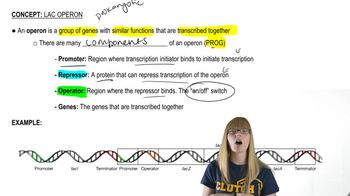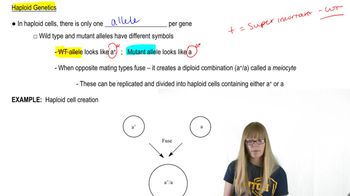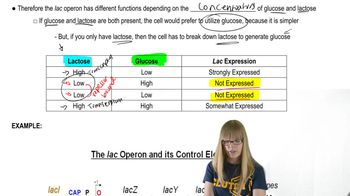Table of contents
- 1. Introduction to Genetics51m
- 2. Mendel's Laws of Inheritance3h 37m
- 3. Extensions to Mendelian Inheritance2h 41m
- 4. Genetic Mapping and Linkage2h 28m
- 5. Genetics of Bacteria and Viruses1h 21m
- 6. Chromosomal Variation1h 48m
- 7. DNA and Chromosome Structure56m
- 8. DNA Replication1h 10m
- 9. Mitosis and Meiosis1h 34m
- 10. Transcription1h 0m
- 11. Translation58m
- 12. Gene Regulation in Prokaryotes1h 19m
- 13. Gene Regulation in Eukaryotes44m
- 14. Genetic Control of Development44m
- 15. Genomes and Genomics1h 50m
- 16. Transposable Elements47m
- 17. Mutation, Repair, and Recombination1h 6m
- 18. Molecular Genetic Tools19m
- 19. Cancer Genetics29m
- 20. Quantitative Genetics1h 26m
- 21. Population Genetics50m
- 22. Evolutionary Genetics29m
12. Gene Regulation in Prokaryotes
Lac Operon
Problem 17c
Textbook Question
Identify which of the following lac operon haploid genotypes transcribe operon genes inducibly and which transcribe genes constitutively. Indicate whether the strain is lac⁺ (able to grow on lactose-only medium) or lac⁻ (cannot grow on lactose medium).
I⁺ P⁺ O⁺ Z⁻ Y⁺
 Verified step by step guidance
Verified step by step guidance1
Identify the components of the lac operon: I (repressor), P (promoter), O (operator), Z (β-galactosidase), and Y (permease).
Determine the functionality of each component in the given genotype: I⁺ (functional repressor), P⁺ (functional promoter), O⁺ (functional operator), Z⁻ (non-functional β-galactosidase), Y⁺ (functional permease).
Assess the ability of the operon to be inducibly transcribed: Since I⁺ is functional, it can bind to the operator O⁺ and block transcription in the absence of an inducer. In the presence of an inducer, the repressor will not bind, allowing transcription.
Evaluate the ability of the operon to transcribe constitutively: The presence of a functional repressor (I⁺) and operator (O⁺) means the operon is not constitutively active; it requires an inducer for transcription.
Determine the lac phenotype: Since Z⁻ is non-functional, the strain cannot produce β-galactosidase, which is necessary for lactose metabolism, making the strain lac⁻ (cannot grow on lactose-only medium).
Recommended similar problem, with video answer:
 Verified Solution
Verified SolutionThis video solution was recommended by our tutors as helpful for the problem above
Video duration:
3mPlay a video:
Was this helpful?
Key Concepts
Here are the essential concepts you must grasp in order to answer the question correctly.
Lac Operon Structure
The lac operon is a set of genes in E. coli that are involved in the metabolism of lactose. It consists of structural genes (Z, Y, A) and regulatory elements (promoter P and operator O). The operon is controlled by the presence or absence of lactose, which influences whether the genes are transcribed. Understanding the structure is essential for determining how mutations affect gene expression.
Recommended video:
Guided course

Lac Operon Overview
Inducible vs. Constitutive Expression
Inducible expression refers to genes that are turned on in response to specific signals, such as the presence of lactose in the case of the lac operon. In contrast, constitutive expression occurs when genes are continuously expressed regardless of environmental conditions. Identifying whether a genotype leads to inducible or constitutive expression is crucial for predicting the growth capabilities of the strain on lactose.
Recommended video:
Guided course

Penetrance and Expressivity
Haploid Genotypes and Mutations
Haploid genotypes contain a single set of chromosomes, making them particularly useful for studying gene function and mutations. In the context of the lac operon, mutations in genes such as Z (β-galactosidase) or Y (lactose permease) can affect the operon's ability to metabolize lactose. Understanding how these mutations influence the operon's function is key to determining whether a strain is lac⁺ or lac⁻.
Recommended video:
Guided course

Haploid Genetics

 4:27m
4:27mWatch next
Master Lac Operon Overview with a bite sized video explanation from Kylia Goodner
Start learning


